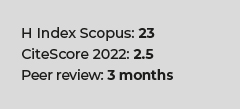Climate variability and malaria transmissin in Loreto, Peru: 1995-2007
DOI:
https://doi.org/10.17843/rpmesp.2009.261.1326Keywords:
Malaria, Grenhouse effect, Climate effects, Climatic processes, PeruAbstract
Objectives. To explore the relationship between climatic variables with the transmission of malaria in Loreto, in a period of 13 years. Material and methods. Ecological study was conducted with data from the monthly average temperature (º C), relative humidity (%), precipitation (mm) and the level of the Amazon River (meters), with cases of malaria confirmed by thick smear recorded by the Dirección Regional de Salud de Loreto. In addition, it was used simple linear regression and multiple linear regression models to determine relationship between these variables and malaria transmission. Results. We found significant negative correlation between temperature and cases of malaria for five years: 1997, 1999, 2003, 2005 and 2006; river level for four years: 1997, 1998, 2003 and 2005; and humidity for three years: 1996, 2005, 2006. No association was found for any years with rainfall. The multiple regression models were significant in three years (1999, 2003 and 2006) with R2 values between 0.870 and 0.937. Conclusions. Some climate variables may be associated with the transmission of malaria, but the importance of each one may vary from year to year. The years of El Niño or later years are the best correlation. When the average temperature is low, it’s probably that the sporozoite cycle vector and gametocyte cycle vector are advantaged. It is at this time that the potential for transmission of the vector population is high, which favors the transmission of malaria.Downloads
Download data is not yet available.
Downloads
Published
2009-03-31
Issue
Section
Research Articles
How to Cite
1.
Ramal C, Vásquez J, Magallanes J, Carey C. Climate variability and malaria transmissin in Loreto, Peru: 1995-2007. Rev Peru Med Exp Salud Publica [Internet]. 2009 Mar. 31 [cited 2024 Apr. 19];26(1). Available from: https://rpmesp.ins.gob.pe/index.php/rpmesp/article/view/1326



























